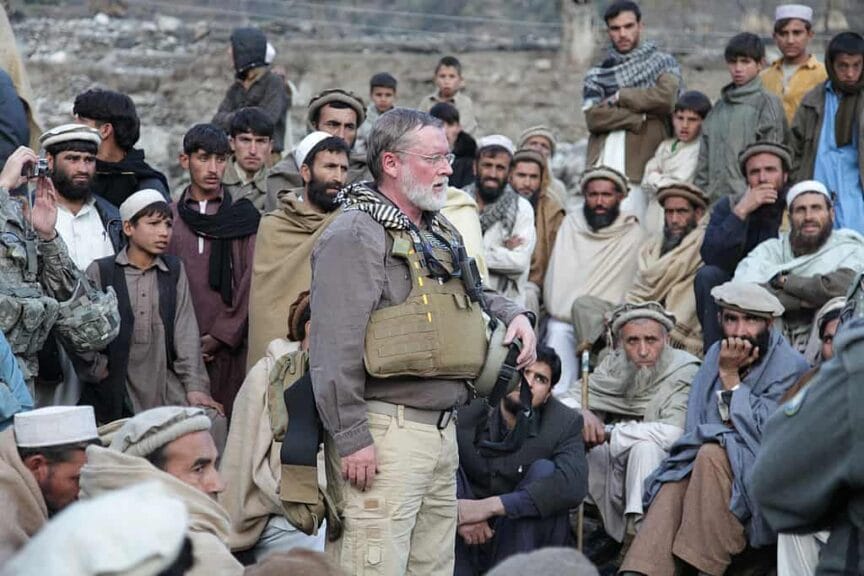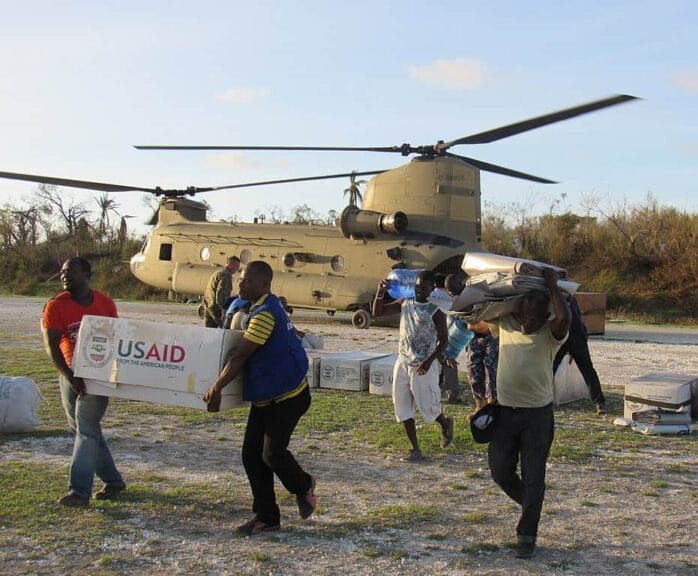When Elon Musk, DOGE, and President Trump halted funding for foreign aid and the U.S. Agency of International Development (USAID), the response from the public made it clear that the American people don’t understand the importance of this agency and how it has kept our country safe for decades. Misinformation coming from Elon Musk and President Trump certainly didn’t help.
One of the false rumors was that USAID sent $50 million worth of condoms to Gaza. That rumor morphed into $50 million in condoms for the terrorist group in Gaza, Hamas. Trump has a habit of increasing numbers that are part of his lies, so the final result of that rumor was that USAID sent $100 million in condoms to Hamas and the group used them to build bombs. None of that is true. The truth: $50 million in condoms was sent to Gaza in Africa when they were experiencing a spike in AIDS cases.
There was also the transgender opera and comic books, even though neither of those was funded by USAID. These lies about all of the wasteful spending (while there are programs we shouldn’t be funding, particularly the regime change attempts in other countries) created an anger and disdain for the work USAID was doing around the world and a misunderstanding of why it’s so important. Since we exited the world stage, China has begun to take the place of the U.S. in foreign aid.
Contents
The Impact of Foreign Aid Agencies
Foreign aid agencies play a critical role in shaping the socio-economic landscape of many countries around the world. From combating poverty to providing disaster relief, these organizations are pivotal in addressing global challenges. This article will explore the origins of foreign aid agencies, their positive effects, the workforce that drives their mission, and the crucial role foreign aid plays in national security. We hope to educate people in order to develop a deeper understanding of the impact these agencies have on both foreign nations receiving the services and the global community at large.
The Origins of Foreign Aid Agencies
Who Started It All?
The concept of foreign aid dates back to the aftermath of World War II, when countries recognized the need to support war-torn nations in their recovery. The establishment of the Marshall Plan in 1948 marked a significant turning point; the United States provided substantial financial aid to rebuild European economies. This initiative set the stage for the formalization of foreign aid agencies, with many countries following suit in creating their own institutions dedicated to international assistance.
Organizations like the United Nations Development Programme (UNDP) and the World Bank emerged to provide a more structured approach to aid distribution. They aimed to address not only immediate humanitarian needs but also the long-term development goals of countries. Today, there are numerous foreign aid agencies operating globally, each with its own mandate and areas of focus, from health care to infrastructure development.
The Motivations Behind Establishing Agencies
The motivations for establishing foreign aid agencies are many. On one hand, there’s a genuine altruistic desire to help those in need, driven by humanitarian principles. On the other hand, geopolitical interests often influence aid distribution, as countries seek to foster alliances and promote stability in regions that may affect their national security.
In many cases, economic motives play a role as well. By aiding developing countries, nations can create markets for their goods and services, thus benefiting economically in the long run. This blend of altruism and self-interest is an important part of understanding the dynamics of foreign aid, as agencies try to balance immediate humanitarian needs with broader geopolitical strategies.
The Positive Effects of Foreign Aid
How It Transforms Lives Globally
Foreign aid has the potential to radically transform lives, especially in underdeveloped regions. By providing resources for education, healthcare, and infrastructure, these agencies enable communities to improve their standard of living. For instance, child mortality rates have significantly decreased in regions that received substantial health aid, as foreign aid has funded vaccinations and healthcare programs.
Moreover, foreign aid helps in building essential infrastructure like roads, schools, and hospitals, which are crucial for a country’s development. These investments not only enhance the quality of life but also create job opportunities, creating economic growth. In many cases, foreign aid empowers communities to become self-sufficient, paving the way for sustainable development. Infrastructure projects are China’s method of using soft power and has helped the country outpace the U.S. in foreign aid. That’s not a good thing.
Success Stories from Around the World
There are countless success stories that illustrate the positive impact of foreign aid agencies. For example, in Ethiopia, a significant investment in agricultural programs has led to increased food production and improved food security. The introduction of better farming techniques and seeds, funded by foreign aid, allowed many families to lift themselves out of poverty.
Another notable example is the Global Fund to Fight AIDS, Tuberculosis, and Malaria. This organization has dramatically reduced the prevalence of these diseases in many low-income countries by providing funding for treatment and prevention programs. It showcases how targeted foreign aid can lead to substantial improvements in public health outcomes, demonstrating the transformative power of international assistance. People will ask why we should spend our money treating diseases in other countries. Disease does not honor borders. We saw what happened when COVID broke out in China. It didn’t stay in the country, it rapidly spread to every country in the world.
The Workforce Behind the Mission

Meet the Federal Workers
The success of foreign aid programs relies heavily on the dedicated workforce behind them. This includes not only the diplomats and policymakers who design the programs but also the countless field workers who implement them on the ground. These individuals often face significant challenges, from language barriers to cultural differences, yet their commitment to humanitarian work remains unwavering. This was showcased by the emotions expressed by USAID when funding was cut. They were devastated by the negative impact it was going to have on their assigned country.
An AIDS program in South Africa was treating pregnant women with medication that would prevent their babies from being born with HIV. When the funding was frozen thousands of babies were born with HIV. A devastating impact on a population these workers cared about.
Foreign aid agencies employ a diverse range of professionals, including engineers, health specialists, educators, and social workers. This multidisciplinary approach is vital for addressing the complex challenges that many aid recipients face. The collaboration between various sectors and expertise enables agencies to implement more effective solutions tailored to the specific needs of communities.

Numbers: How Many Are There Globally?
Estimating the exact number of foreign aid agencies worldwide can be challenging due to the variations in definitions and classifications. However, it’s widely accepted that there are thousands of organizations, ranging from governmental bodies to non-governmental organizations (NGOs) and international institutions. Each plays a unique role in the aid landscape.
According to recent estimates, there are over 1,800 registered NGOs involved in foreign aid and development across various regions. Additionally, many countries have their own government-sponsored aid programs, contributing to the overall number of entities engaged in international assistance. This extensive network highlights the global commitment to humanitarian efforts and the diverse approaches taken to address poverty and development challenges.
National Security and Foreign Aid
Why It Matters to Our Safety
The connection between foreign aid and national security is often overlooked but is of paramount importance. Providing aid to developing countries can help stabilize regions plagued by conflict, poverty, and political instability. By investing in these areas, foreign nations can reduce the likelihood of crises that may lead to refugee flows, terrorism, or other security threats. Providing aid to citizens of a country where terrorist organizations are rooted protects the United States from attacks and thwarts the recruiting efforts of these organizations by showing the citizens that the U.S. isn’t the enemy.
International assistance can foster goodwill and build partnerships, which are essential for maintaining peace and security. When countries collaborate on aid initiatives, they establish networks that can facilitate communication and cooperation in times of crisis. This proactive approach to global instability is essential in an era where national and global security challenges are increasingly interconnected.
The Role of Aid in Global Stability
In addition to immediate security benefits, foreign aid can contribute to long-term stability by addressing the root causes of conflict. By promoting economic development, education, and good governance, aid can help create a more resilient society less prone to unrest. Countries that receive substantial support in these areas often experience lower levels of violence and conflict, contributing to a more stable global environment.
Successful foreign aid programs can serve as a model for other nations, demonstrating the benefits of international collaboration and support. This ripple effect is important for creating a culture of peace and cooperation, enhancing global stability in the face of emerging challenges.
Foreign aid agencies have an undeniable impact on global development, providing assistance that transforms lives and creates a more secure world. From their origins in post-war recovery efforts to their current role in addressing complex global challenges, these organizations play a crucial part in the international community. They not only tackle immediate needs but also work towards long-term solutions that empower communities and promote stability.
By understanding the multitude of motivations behind foreign aid, the dedicated workforce that drives these initiatives, and the vital connection to national security, we can better appreciate the importance of these agencies in shaping a brighter future for all. The road ahead may be filled with challenges, but the potential for positive change remains high, driven by the collective efforts of governments, NGOs, and the communities they serve.
FAQs
What is the main purpose of foreign aid agencies?
The primary purpose of foreign aid agencies is to provide humanitarian assistance, support economic development, and promote stability in various regions worldwide. They aim to address immediate needs while fostering long-term growth and self-sufficiency in recipient countries.
How does foreign aid help in national security?
Foreign aid contributes to national security by stabilizing regions that may pose threats, such as poverty or conflict. By investing in development, education, and infrastructure, foreign aid can reduce the risk of crises that lead to instability or violence.
Are foreign aid agencies effective?
While the effectiveness of foreign aid agencies can vary, many have demonstrated significant positive outcomes in health, education, and economic development. Success stories highlight the transformative impact of targeted aid initiatives, although challenges remain in ensuring accountability and measurable results.
How are foreign aid agencies funded?
Foreign aid agencies are typically funded through government budgets, private donations, and international contributions. This funding allows them to implement various programs and allocate resources where they are most needed.
Can foreign aid create dependency?
There is a concern that foreign aid can create dependency in some cases, where recipients rely on assistance instead of developing self-sustaining solutions. However, many agencies aim to empower communities and foster independence through their initiatives.
In summary, foreign aid agencies play an essential role in addressing global challenges by providing support, fostering development, and promoting stability. Their efforts not only help those in need but also contribute to a safer, more secure world for all.




